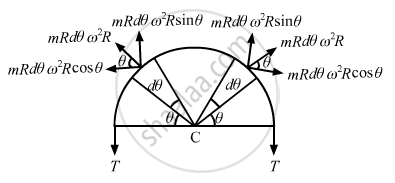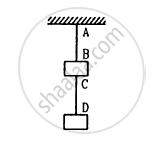Advertisements
Advertisements
Question
A circular loop of string rotates about its axis on a frictionless horizontal place at a uniform rate so that the tangential speed of any particle of the string is ν. If a small transverse disturbance is produced at a point of the loop, with what speed (relative to the string) will this disturbance travel on the string?
Solution
Let,
V = Linear velocity of the string
m = Mass per unit length of the the string.
R = Radius of the loop
ω = Angular velocity
Consider one half of the string, as shown in the figure.
The half loop experiences centrifugal force at every point (away from the centre) balanced by tension 2T.
Consider an element of angular part dθ at angle θ.
So,
Length of the element
\[= Rd\theta, mass = mRd\theta\]
Centrifugal force experienced by the element
\[= \left( mRd\theta \right) \omega^2 R\]
Resolving the centrifugal force into rectangular components,
Since the horizontal components cancel each other, the net force on the two symmetric elements is given as
\[dF = 2m R^2 d\theta \omega^2 sin\theta\]
\[Total force, F = \int_0^\pi/2 2m R^2 \omega^2 \sin\theta d\theta\]
\[= 2m R^2 \omega^2 \left[ - \cos \theta \right]\]
\[ = 2m R^2 \omega^2 \]
\[And, \]
\[2T = 2m R^2 \omega^2 \]
\[ \Rightarrow T = m R^2 \omega^2\]
Velocity of the transverse vibration is given as
\[V' = \sqrt{\left( \frac{T}{m} \right)}\]
\[V' = \sqrt{\left( \frac{m R^2 \omega^2}{m} \right)} = \omega R\]
Linear velocity of the string, V = \[\omega R\]
∴ Speed of the disturbance, V' = V
APPEARS IN
RELATED QUESTIONS
When longitudinal wave is incident at the boundary of denser medium, then............................
- compression reflects as a compression.
- compression reflects as a rarefaction.
- rarefaction reflects as a compression.
- longitudinal wave reflects as transverse wave.
When a transverse wave on a string is reflected from the free end, the phase change produced is ..............
(a) zero rad
(b) ` pi/2 ` rad
(c) `(3pi)/4` rad
(d) `pi` rad
Given below are some functions of x and t to represent the displacement (transverse or longitudinal) of an elastic wave. State which of these represent (i) a traveling wave, (ii) a stationary wave or (iii) none at all:
y = cos x sin t + cos 2x sin 2t
Explain why (or how) The shape of a pulse gets distorted during propagation in a dispersive medium.
Explain the reflection of transverse and longitudinal waves from a denser medium and a rared medium.
You are walking along a seashore and a mild wind is blowing. Is the motion of air a wave motion?
Longitudinal waves cannot
A wave moving in a gas
A steel wire of length 64 cm weighs 5 g. If it is stretched by a force of 8 N, what would be the speed of a transverse wave passing on it?
A vertical rod is hit at one end. What kind of wave propagates in the rod if (a) the hit is made vertically (b) the hit is made horizontally?
A transverse wave described by \[y = \left( 0 \cdot 02 m \right) \sin \left( 1 \cdot 0 m^{- 1} \right) x + \left( 30 s^{- 1} \right)t\] propagates on a stretched string having a linear mass density of \[1 \cdot 2 \times {10}^{- 4} kg m^{- 1}\] the tension in the string.
Two blocks each having a mass of 3⋅2 kg are connected by a wire CD and the system is suspended from the ceiling by another wire AB (See following figure). The linear mass density of the wire AB is 10 g m−1 and that of CD is 8 g m−1. Find the speed of a transverse wave pulse produced in AB and CD.

An organ pipe, open at both ends, contains
A heavy but uniform rope of length L is suspended from a ceiling. (a) Write the velocity of a transverse wave travelling on the string as a function of the distance from the lower end. (b) If the rope is given a sudden sideways jerk at the bottom, how long will it take for the pulse to reach the ceiling? (c) A particle is dropped from the ceiling at the instant the bottom end is given the jerk. Where will the particle meet the pulse?
A tuning fork of frequency 440 Hz is attached to a long string of linear mass density 0⋅01 kg m−1 kept under a tension of 49 N. The fork produces transverse waves of amplitude 0⋅50 mm on the string. (a) Find the wave speed and the wavelength of the waves. (b) Find the maximum speed and acceleration of a particle of the string. (c) At what average rate is the tuning fork transmitting energy to the string?
A steel wire of mass 4⋅0 g and length 80 cm is fixed at the two ends. The tension in the wire is 50 N. Find the frequency and wavelength of the fourth harmonic of the fundamental.
A wire, fixed at both ends is seen to vibrate at a resonant frequency of 240 Hz and also at 320 Hz. (a) What could be the maximum value of the fundamental frequency? (b) If transverse waves can travel on this string at a speed of 40 m s−1, what is its length?
The phenomenon of beats can take place
